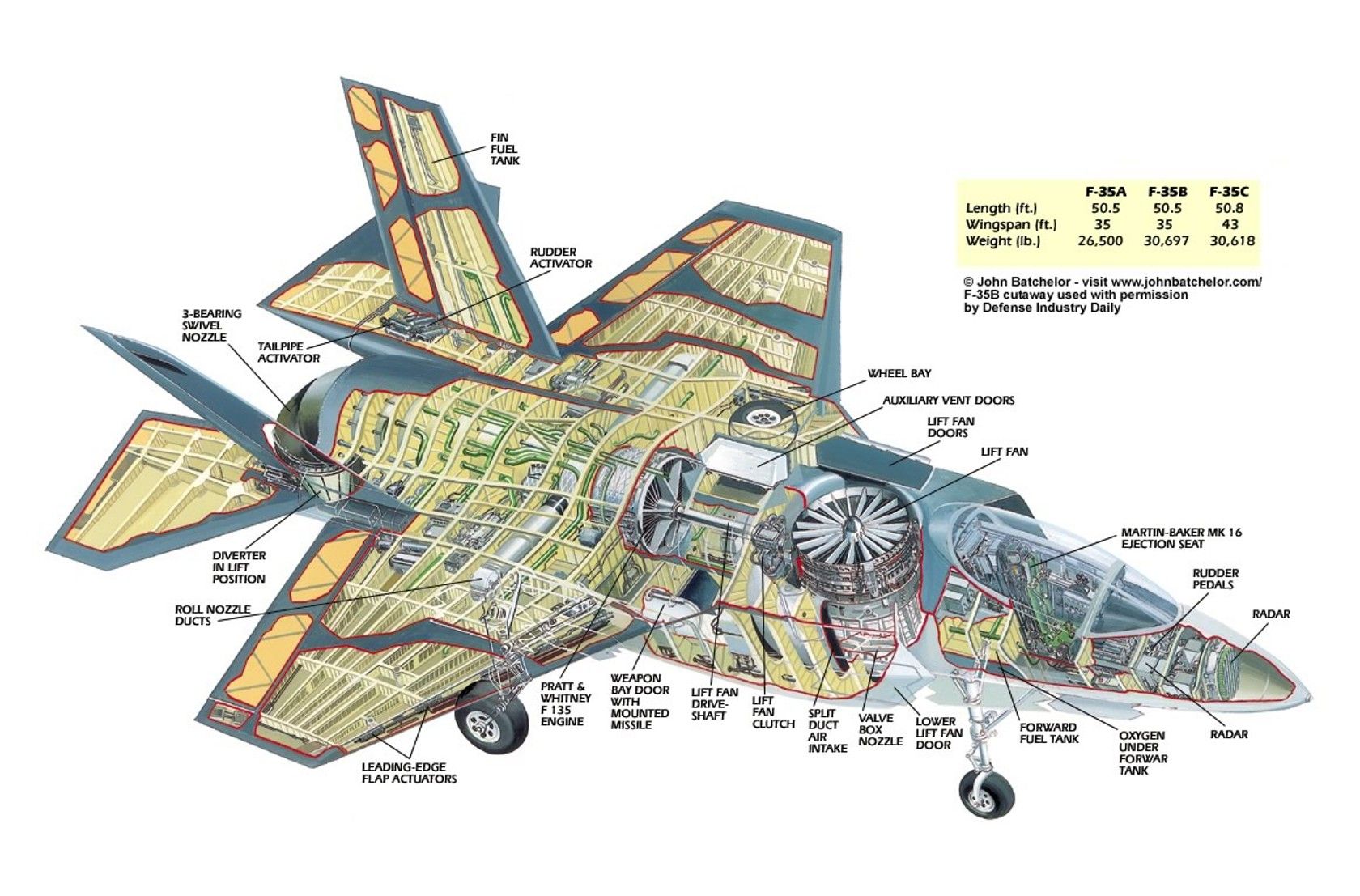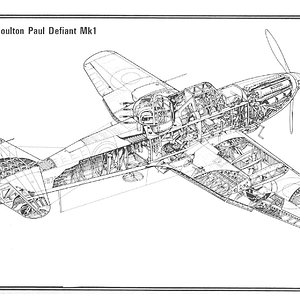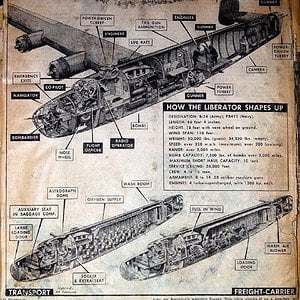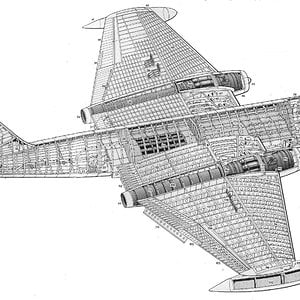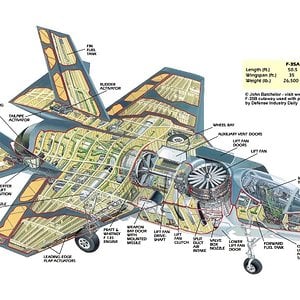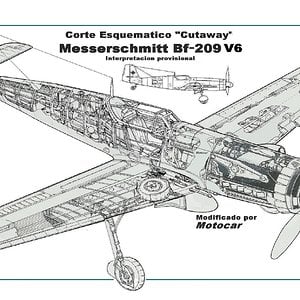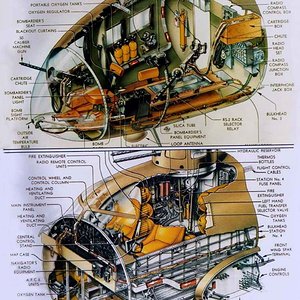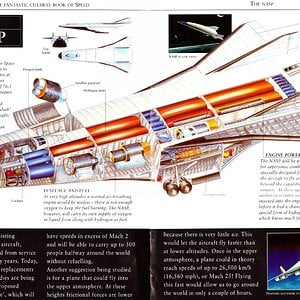Navigation
Install the app
How to install the app on iOS
Follow along with the video below to see how to install our site as a web app on your home screen.
Note: This feature may not be available in some browsers.
More options
You are using an out of date browser. It may not display this or other websites correctly.
You should upgrade or use an alternative browser.
You should upgrade or use an alternative browser.
F-35B
The Pratt & Whitney F135 engine with lift fan, roll posts, and rear vectoring nozzle, as designed for the F-35B, at the Paris Air Show, 2007
F-35B vertical landing during its first sea trials aboard USS Wasp, October 2011.
F-35B short-takeoff from USS Wasp during its first sea trials, October 2011.
The F-35B is the short takeoff and vertical landing (STOVL) variant of the aircraft. Similar in size to the A variant, the B sacrifices about a third of the other version's fuel volume to make room for the vertical flight system. Takeoffs and landing with vertical flight systems are by far the riskiest, and in the end, a decisive factor in design. Like the AV-8B Harrier II, the B’s guns will be carried in a ventral pod. Whereas the F-35A is stressed to 9 g, the F-35B is stressed to 7 g. The F-35B was unveiled at Lockheed Martin's Fort Worth plant on 18 December 2007,[420] and the first test flight was on 11 June 2008
Unlike the other variants, because it can land vertically the F-35B has no landing hook. The "STOVL/HOOK" button in the cockpit initiates conversion instead of dropping the hook. The F-35B sends jet thrust directly downwards during vertical takeoffs and landing and the nozzle is being redesigned to spread the output out in an oval rather than a small circle so as to limit damage to asphalt and ship decks. The variant's three-bearing swivel nozzle that directs the full thrust of the afterburning jet engine is moved by a “fueldraulic” actuator, using pressurized jet fuel.
The United States Marine Corps plans to purchase 340 F-35Bs, to replace all current inventories of the F/A-18 Hornet (A, B, C and D-models), and AV-8B Harrier II in the fighter, and attack roles. The Marines are planning to use the F-35B from "unimproved surfaces at austere bases" and are preparing landing spots with "special, high-temperature concrete designed to handle the heat from the JSF".
The Royal Air Force and Royal Navy plan to use the F-35B to replace their Harrier GR9s, which were retired in 2010. One of the Royal Navy requirements for the F-35B design was a Shipborne Rolling and Vertical Landing (SRVL) mode to increase the maximum landing weights for carried weapons via wing lift. In October 2010, the UK announced plans to order to the CATOBAR F-35C variant instead, but in May 2012 the UK reverted back to purchasing the F-35B, citing the cost of equipping the UK's new aircraft carriers for the F-35C.
The Italian Navy is preparing Grottaglie Air Station for future operations with the F-35B. The Italian Navy is to receive 22 aircraft between 2014 and 2021, with its Cavour aircraft carrier set to be modified to operate them by 2016.Commandant of the U.S. Marine Corps, General James Amos has said that, in spite of its increasing costs and schedule delays, there is no plan B to substitute for the F-35B. The F-35B is larger than the aircraft it replaces, which required USS America to be designed without needed well deck capabilities. In 2011, the USMC and USN signed an agreement that the USMC will purchase 340 F-35B and 80 F-35C fighters while the USN will purchase 260 F-35C fighters. The five squadrons of USMC F-35Cs will be assigned to the Navy carriers while the USMC F-35Bs will be used on amphibious ships and ashore.
On 6 January 2011, Gates said that the 2012 budget would call for a two-year pause in F-35B production during which the aircraft may be redesigned, or canceled if unsuccessful. In 2011, Lockheed Martin executive vice president Tom Burbage and former Pentagon director of operational testing Tom Christie stated that most program delays were due to issues with the F-35B, which forced massive redesigns on the other versions. The probation status was ended by Defense Secretary Leon Panetta in January 2012 due to progress made over the past year.
Lockheed Martin Vice President Steve O’Bryan has said that most F-35B landings will be purely conventional in order to reduce stress on the vertical lift components. Conventional operations also reduce the risk of self-induced foreign object damage. On 3 October 2011, the F-35B began its initial sea-trials by performing a vertical landing on the deck of the amphibious assault ship USS Wasp.
The USMC intends to declare Initial Operational Capability with about 50 F-35s running interim Block 2B software in the 2014 to 2015 timeframe.] The USAF had considered replacing the A-10 with the F-35B, but will not do so due to the F-35B being unable to generate sufficient sorties.
Differences between variants
F-35A
CTOL F-35B
STOVL F-35C
CATOBAR
Length 51.4 ft (15.7 m) 51.3 ft (15.6 m) 51.5 ft (15.7 m)
Wingspan 35 ft (10.7 m) 35 ft (10.7 m) 43 ft (13.1 m)
Wing Area 460 ft² (42.7 m²) 460 ft² (42.7 m²) 668 ft² (62.1 m²)
Empty weight 29,300 lb (13,300 kg) 32,300 lb (14,700 kg) 34,800 lb (15,800 kg)
Internal fuel 18,250 lb (8,280 kg) 13,500 lb (6,125 kg) 19,750 lb (8,860 kg)
Max takeoff weight 70,000 lb class (31,800 kg) 60,000 lb class (27,300 kg) 70,000 lb class (31,800 kg)
Range 1,200 nmi (2,220 km) 900 nmi (1,670 km) 1,400 nmi (2,520 km)
Combat radius on
internal fuel[483] 584 nmi (1,082 km) 469 nmi (869 km) 615 nmi (1,141 km)
Thrust/weight
• full fuel:
• 50% fuel: 0.87
1.07 0.90
1.04 0.75
0.91
The Pratt & Whitney F135 engine with lift fan, roll posts, and rear vectoring nozzle, as designed for the F-35B, at the Paris Air Show, 2007
F-35B vertical landing during its first sea trials aboard USS Wasp, October 2011.
F-35B short-takeoff from USS Wasp during its first sea trials, October 2011.
The F-35B is the short takeoff and vertical landing (STOVL) variant of the aircraft. Similar in size to the A variant, the B sacrifices about a third of the other version's fuel volume to make room for the vertical flight system. Takeoffs and landing with vertical flight systems are by far the riskiest, and in the end, a decisive factor in design. Like the AV-8B Harrier II, the B’s guns will be carried in a ventral pod. Whereas the F-35A is stressed to 9 g, the F-35B is stressed to 7 g. The F-35B was unveiled at Lockheed Martin's Fort Worth plant on 18 December 2007,[420] and the first test flight was on 11 June 2008
Unlike the other variants, because it can land vertically the F-35B has no landing hook. The "STOVL/HOOK" button in the cockpit initiates conversion instead of dropping the hook. The F-35B sends jet thrust directly downwards during vertical takeoffs and landing and the nozzle is being redesigned to spread the output out in an oval rather than a small circle so as to limit damage to asphalt and ship decks. The variant's three-bearing swivel nozzle that directs the full thrust of the afterburning jet engine is moved by a “fueldraulic” actuator, using pressurized jet fuel.
The United States Marine Corps plans to purchase 340 F-35Bs, to replace all current inventories of the F/A-18 Hornet (A, B, C and D-models), and AV-8B Harrier II in the fighter, and attack roles. The Marines are planning to use the F-35B from "unimproved surfaces at austere bases" and are preparing landing spots with "special, high-temperature concrete designed to handle the heat from the JSF".
The Royal Air Force and Royal Navy plan to use the F-35B to replace their Harrier GR9s, which were retired in 2010. One of the Royal Navy requirements for the F-35B design was a Shipborne Rolling and Vertical Landing (SRVL) mode to increase the maximum landing weights for carried weapons via wing lift. In October 2010, the UK announced plans to order to the CATOBAR F-35C variant instead, but in May 2012 the UK reverted back to purchasing the F-35B, citing the cost of equipping the UK's new aircraft carriers for the F-35C.
The Italian Navy is preparing Grottaglie Air Station for future operations with the F-35B. The Italian Navy is to receive 22 aircraft between 2014 and 2021, with its Cavour aircraft carrier set to be modified to operate them by 2016.Commandant of the U.S. Marine Corps, General James Amos has said that, in spite of its increasing costs and schedule delays, there is no plan B to substitute for the F-35B. The F-35B is larger than the aircraft it replaces, which required USS America to be designed without needed well deck capabilities. In 2011, the USMC and USN signed an agreement that the USMC will purchase 340 F-35B and 80 F-35C fighters while the USN will purchase 260 F-35C fighters. The five squadrons of USMC F-35Cs will be assigned to the Navy carriers while the USMC F-35Bs will be used on amphibious ships and ashore.
On 6 January 2011, Gates said that the 2012 budget would call for a two-year pause in F-35B production during which the aircraft may be redesigned, or canceled if unsuccessful. In 2011, Lockheed Martin executive vice president Tom Burbage and former Pentagon director of operational testing Tom Christie stated that most program delays were due to issues with the F-35B, which forced massive redesigns on the other versions. The probation status was ended by Defense Secretary Leon Panetta in January 2012 due to progress made over the past year.
Lockheed Martin Vice President Steve O’Bryan has said that most F-35B landings will be purely conventional in order to reduce stress on the vertical lift components. Conventional operations also reduce the risk of self-induced foreign object damage. On 3 October 2011, the F-35B began its initial sea-trials by performing a vertical landing on the deck of the amphibious assault ship USS Wasp.
The USMC intends to declare Initial Operational Capability with about 50 F-35s running interim Block 2B software in the 2014 to 2015 timeframe.] The USAF had considered replacing the A-10 with the F-35B, but will not do so due to the F-35B being unable to generate sufficient sorties.
Differences between variants
F-35A
CTOL F-35B
STOVL F-35C
CATOBAR
Length 51.4 ft (15.7 m) 51.3 ft (15.6 m) 51.5 ft (15.7 m)
Wingspan 35 ft (10.7 m) 35 ft (10.7 m) 43 ft (13.1 m)
Wing Area 460 ft² (42.7 m²) 460 ft² (42.7 m²) 668 ft² (62.1 m²)
Empty weight 29,300 lb (13,300 kg) 32,300 lb (14,700 kg) 34,800 lb (15,800 kg)
Internal fuel 18,250 lb (8,280 kg) 13,500 lb (6,125 kg) 19,750 lb (8,860 kg)
Max takeoff weight 70,000 lb class (31,800 kg) 60,000 lb class (27,300 kg) 70,000 lb class (31,800 kg)
Range 1,200 nmi (2,220 km) 900 nmi (1,670 km) 1,400 nmi (2,520 km)
Combat radius on
internal fuel[483] 584 nmi (1,082 km) 469 nmi (869 km) 615 nmi (1,141 km)
Thrust/weight
• full fuel:
• 50% fuel: 0.87
1.07 0.90
1.04 0.75
0.91

